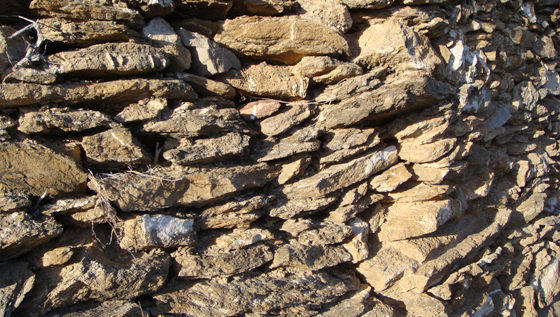
Dry Stone Walls / Arnasco Olive Oil Consortium
This post is also available in:
 Italiano (Italian)
Italiano (Italian)
One of the main features of the Ligurian landscape is the abundant terraces supported by dry stone walls, created with juxtaposed stones and without using any kind of mortars. This is actually part of the centuries-old tradition, which has turned the harsh original slopes, into farming land. Mostly women used to do so in the past, as men were busy fishing at sea.
In addition to allowing the cultivation of fruits and vegetables, these masonry works serve as a vital protection against hydrological instability. That is to say, they contain the soil, despite the pouring rain – especially in coldest months of the year – which easily filter through. This helps preventing stronger and stronger pressure accumulating in the soaked terrain, otherwise impossible to deal with when using simple concrete walls.
The Cooperative Olivicola of Arnasco, in the province of Savona and managed by 300 members, currently owns 250 acres olive grove terraces, supported by 300 kilometres of dry stone walls. This very organization has promoted the dry-stone wall building technique in Italy and abroad for some years now.
Furthermore, given the lack of easily cultivated stretches of land, the Ligurian population has always had to come up with similar ingenious structures all over the region: wide steps, terraces or support strips were always fitted with kilometres of dry stone walls known as “Maixei “in the local dialect.
The name “Maixei” comes Latin “maceries” or “dry stone wall”; it dates back to the Iron Age, around 1.000 BC, when these walls were manually built using roughly squared local stones.
This technique offers another import benefit: stones are already available for free, no transportation costs are involved and, they’ve already adapted to the challenging climate, thus proving the best-ever material to use.
Building a drystone wall has always meant carefully measuring the slight inclination of the ground and taking it into account in order to guarantee the free flow of water through the interstices between one stone and another
When the rain was heavy enough to trigger massive landslides, the damages were very limited unlike today’s floods because of simple concrete walls – in this case, water can penetrate them, accumulate and eventually drag everything downstream.
Drywalls have always been a true icon of Liguria; their replacement would be tantamount to the destruction of a centuries-old tradition, as they are true examples of sophisticated architecture blended with a pleasant naturalistic impact.
Great and important examples of drywalls can be seen on the Eastern Riviera (“Riviera di Levante”), in the “Cinqueterre” area – where vineyards are abundant -, and in the Western Riviera (“Riviera di Ponente”) – popular for olive trees.
Most unfortunately, the centuries-old drywall building technique has become less and less popular, as well as regular and proper maintenance. This has caused many pieces of farming land to be eventually discarded or even abandoned. We should not forget that those very drywalls are evidence of how peasants and farmers were able to live and cope with a pretty hostile territory full of hills, mountains and slopes overlooking the sea.
In addition to the cultivation of vines and olive trees, fodder, cereals and vegetables were also grown on those drywalled slopes. As mentioned before, stones were already locally available, totally free and thus made a big, positive impact on the development of local great prosperity.
The Ligurian terraces have always represented a specific ecosystem for the presence of animal and plant species. For this reason, in 2014, the Region allocated more than thirty million euros to safeguard and respect these precious resources through specific actions, as per the official rural development program.
In order to fully understand the very importance of all this, just think of China’s Great Wall: its extension is sensibly shorter than that of Ligurian drywalls.
It is therefore imperative to preserve and protect this Ligurian heritage for many years to come.
(source, http://www.restauroeconservazione.info/la-tradizione-costruttiva-dei-maixei-muretti-secco-liguri/)
This post is also available in:
 Italiano (Italian)
Italiano (Italian)



